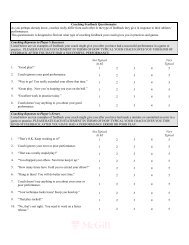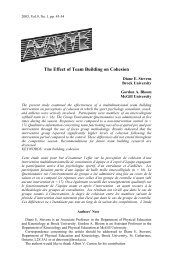International Journal of Sport Psychology
International Journal of Sport Psychology
International Journal of Sport Psychology
You also want an ePaper? Increase the reach of your titles
YUMPU automatically turns print PDFs into web optimized ePapers that Google loves.
would result in greater intrinsic motivation and thus more positive cognitive,<br />
affective and behavioral outcomes. Examination <strong>of</strong> the present consultant<br />
opinions <strong>of</strong> the pr<strong>of</strong>iling procedure suggest that they believe pr<strong>of</strong>iling could<br />
be useful in facilitating these motivational mediators (e.g., enhancing athlete<br />
confidence, providing more athlete control and facilitating interaction within<br />
the team) in addition to having a positive impact upon athlete intrinsic motivation<br />
and self determination. Given the present findings and strong theoretical<br />
rationale for the influence <strong>of</strong> pr<strong>of</strong>iling on athlete intrinsic motivation,<br />
further experimental research is required to investigate whether single, or<br />
repeated, pr<strong>of</strong>iling interventions are able to significantly improve athlete<br />
intrinsic motivation. Furthermore, it would be useful to see whether any<br />
changes in athlete intrinsic motivation as a result <strong>of</strong> a pr<strong>of</strong>iling intervention<br />
are mirrored by changes in motivational mediators and consequences as proposed<br />
by Deci and Ryan’s CET.<br />
The team related benefits <strong>of</strong> performance pr<strong>of</strong>iling in a group setting<br />
found in the present survey included helping to identify roles, understanding<br />
various positional demands in the team, improving team dynamics and facilitating<br />
communication, discussion and interaction within teams. These findings<br />
support and extend those <strong>of</strong> Dale and Wrisberg (1996) and suggest that<br />
sport psychology practitioners believe that the pr<strong>of</strong>iling procedure has a<br />
number <strong>of</strong> beneficial team related impacts when conducted in a group setting.<br />
Given that the present study was confined to examining the perceptions<br />
<strong>of</strong> the sport psychology deliverers <strong>of</strong> the pr<strong>of</strong>iling procedure, research is<br />
needed to investigate whether the athlete and coach consumers <strong>of</strong> the strategy<br />
believe there to be similar benefits from the technique. Furthermore,<br />
experimental research is needed to investigate the characteristics <strong>of</strong> pr<strong>of</strong>iling<br />
interventions (e.g., length, duration, frequency, type <strong>of</strong> pr<strong>of</strong>iles, etc.) which<br />
can help to maximise team productivity and cohesion.<br />
The present findings support descriptive research which suggests pr<strong>of</strong>iling<br />
to be useful in helping athletes to assess, evaluate and monitor their<br />
progress (Butler & Hardy, 1992; Butler et al., 1993; Jones, 1993). Doyle and<br />
Parfitt (1997) in their experimental investigation into the construct validity<br />
<strong>of</strong> the technique, suggest that pr<strong>of</strong>iling may only be useful in monitoring<br />
progress over periods where large improvements in performance are likely.<br />
Indeed, lack <strong>of</strong> improvement or decrements in ratings over time could have<br />
a negative impact upon athlete confidence (Butler et al.). Hence, caution<br />
should be taken when employing the technique to monitor athlete progress<br />
in order to avoid the potential negative implications that may result from<br />
non-improvement on quality ratings. In relation to the performance evaluation<br />
benefits <strong>of</strong> pr<strong>of</strong>iling identified by the present consultant population,<br />
366




